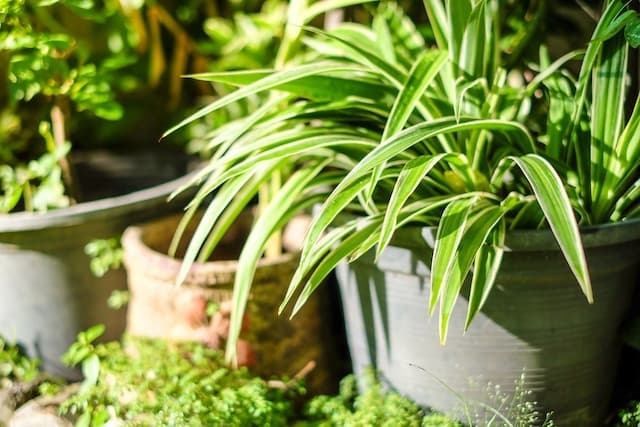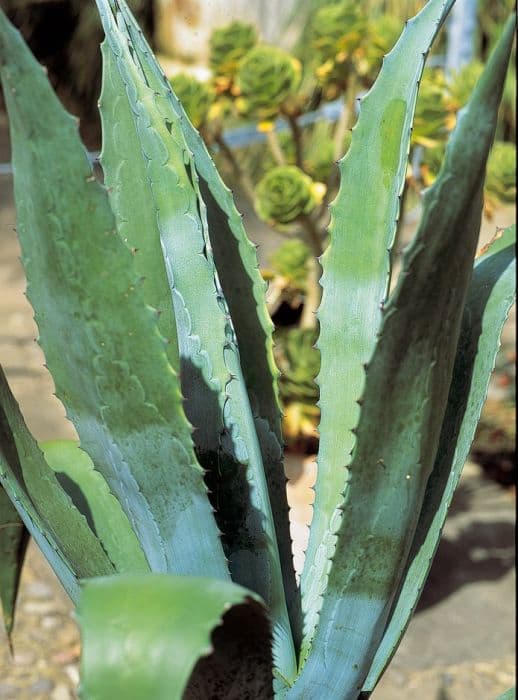Sundance Cordyline Cordyline 'Sundance'

ABOUT
The Cordyline 'Sundance' is an ornamental plant known for its striking foliage. The leaves of this plant are distinctive with their sword-like shape and vibrant coloration. They emerge from a central stem, creating a tufted or rosette-like appearance. The leaves have a glossy texture and display a broad range of colors, typically featuring a blend of greens, pinks, oranges, and reds. These hues may form stripes along the leaves or may be present as a central stripe bordered by green. The edges of the leaves are often gently curved or slightly arching, contributing to the plant's graceful appearance. The Cordyline 'Sundance' can produce small flowers under the right circumstances, although it is predominantly grown for its foliage. The flowers are usually inconspicuous in comparison to the bold statement made by the leaves. Over time, the plant develops a woody stem at its base, and the leaves continue to grow in a cluster at the top, maintaining its lush and exotic look. This plant can add a tropical accent to gardens or indoor spaces, thanks to its colorful and dramatic leaves that create an eye-catching display.
About this plant
 Names
NamesFamily
Asparagaceae.
Synonyms
Sundance Cordyline, Cabbage Palm, Cabbage Tree, Ti Plant, Good Luck Plant.
Common names
Cordyline terminalis 'Sundance', Cordyline fruticosa 'Sundance'.
 Toxicity
ToxicityTo humans
The Cordyline 'Sundance', commonly known as Ti plant, is generally not considered toxic to humans. However, ingestion of the plant can cause mild irritation of the mouth, throat and stomach due to saponins that are present. It is advisable to keep the plant out of reach of children who may be tempted to chew on the leaves.
To pets
Ti plant is known to be toxic to pets, particularly cats and dogs. If a pet ingests part of a Ti plant, it may experience symptoms such as vomiting, drooling, lack of appetite, depression, and in severe cases, dilated pupils or increased heart rate. Immediate veterinary attention is recommended if a pet has consumed any part of the plant.
 Characteristics
CharacteristicsLife cycle
Perennials
Foliage type
Evergreen
Color of leaves
Variegated
Height
3-6 feet (0.91-1.83 meters)
Spread
2-4 feet (0.61-1.22 meters)
Plant type
Shrub
Hardiness zones
9
Native area
New Zealand
Benefits
 General Benefits
General Benefits- Decorative Appeal: Adds a splash of vibrant color with its bright foliage, enhancing the visual interest of garden landscapes and indoor spaces.
- Low Maintenance: Requires minimal care, making it a convenient option for busy gardeners or those with less experience.
- Drought Tolerance: Once established, it can tolerate periods of dryness, reducing the need for frequent watering.
- Adaptability: Capable of growing in a variety of conditions, from full sun to partial shade, which provides flexibility in garden design.
- Evergreen Nature: Maintains its foliage throughout the year, providing a constant display of color even in colder months.
- Texture Contrast: The long, strap-like leaves offer a striking textural contrast when planted alongside plants with different leaf shapes.
- Container Gardening: Well-suited for pots and containers, making it an ideal choice for balconies, patios, or indoor use.
 Medical Properties
Medical PropertiesThis plant is not used for medical purposes.
 Air-purifying Qualities
Air-purifying QualitiesThis plant is not specifically known for air purifying qualities.
 Other Uses
Other Uses- Culinary garnish: The vibrant leaves of the Sundance can be used to add a splash of color to culinary presentations, though the leaves themselves are not edible.
- Fabric dye: The colorful leaves may be boiled to extract natural dyes for fabrics, giving them soft, unique hues.
- Crafts and flower arrangements: The long, striking leaves can be incorporated into floral arrangements or used in various crafts for their form and color.
- Theme gardens: Sundance can be used in thematic gardens, such as tropical or Hawaiian themes, to add authentic foliage.
- Photography: The plant's vivid coloration makes it an excellent subject or backdrop for botanical photography.
- Education: Sundance can be used as a teaching tool to educate about plant variegation and tropical plant care.
- Feng Shui: In the practice of Feng Shui, this plant is used to add an element of wood, which is said to bring balance into the home.
- Mood enhancement: The bright colors of the Sundance may be utilized in horticultural therapy settings to uplift mood and create a stimulating environment.
- Marker plant: Sundance can be planted as a marker in larger gardens to signify a transition between different garden areas due to its distinctive appearance.
- Livestock fodder: While not common and only in dire situations, the leaves might be used as emergency fodder for herbivorous animals, with proper research to ensure it's safe.
Interesting Facts
 Feng Shui
Feng ShuiThe Ti plant, also known as Cordyline 'Sundance', is often used in Feng Shui as it is believed to bring good luck and prosperity. Its upright growth symbolizes reaching upwards, which can be associated with growth and advancement. The vibrant leaves can add a pop of color, energizing the space. It could be placed in the wealth corner of a room, typically the southeast, to activate and enhance that area's energy.
 Zodiac Sign Compitability
Zodiac Sign CompitabilityThe Ti plant is not used in astrology practice.
 Plant Symbolism
Plant Symbolism- Longevity and immortality: Cordylines often symbolize a long life ahead due to their resilience and ability to bounce back from tough conditions, representing perseverance and endurance.
- Good Luck: In some cultures, cordylines are believed to bring good fortune and are often planted around homes for this purpose.
- Purification: The plant is thought to purify the surrounding air and environment, representing cleanliness and purity.
- Spiritual protection: Some believe that the Cordyline 'Sundance' can ward off negative energies or spirits, symbolizing protection and safety.
- Sacredness: In Hawaiian culture, the Ti plant, a cousin of the Cordyline 'Sundance', is considered sacred to the Hawaiian god Lono and the goddess Laka, and may be used in various spiritual rituals.
 Water
WaterThe Ti plant prefers to be kept consistently moist but not waterlogged. Water the plant thoroughly when the top inch of the soil feels dry to the touch, which may be approximately once a week, but frequency can vary depending on environmental conditions. Generally, during the growing season, the Ti plant may require about 16 to 24 onzes of water per watering session. Be cautious during the winter months to reduce watering frequency, as the plant's water requirements will decrease with slower growth. Ensure that any excess water is allowed to drain away to prevent root rot.
 Light
LightTi plants thrive best in bright, indirect sunlight. The ideal location for a Ti plant would be a spot where it gets filtered light, such as near an east-facing or west-facing window with sheer curtains to diffuse direct sun rays. Direct sunlight can scorch the leaves, while too little light can cause the leaves to lose their vibrant color.
 Temperature
TemperatureTi plants prefer warm temperatures ranging from 65 to 80 degrees Fahrenheit for optimal growth. They can tolerate a minimum temperature of around 50 degrees Fahrenheit, but they should not be exposed to temperatures below this as they can suffer damage. The ideal conditions would be consistently warm temperatures without significant fluctuations.
 Pruning
PruningPruning Ti plants is generally done to maintain their shape, remove any dead or damaged foliage, and encourage bushier growth. The best time to prune is in the spring or early summer before the plant's growth season is in full swing. You can prune Ti plants as often as needed to remove old leaves but avoid excessive pruning which could stress the plant.
 Cleaning
CleaningAs needed
 Soil
SoilThe Cordyline 'Sundance', commonly known as Ti plant, thrives best in a well-draining soil mix comprising of peat, perlite, and pine bark. Aim for a slightly acidic to neutral pH between 6.0 and 7.0 for optimal growth.
 Repotting
RepottingTi plants should be repotted every 2-3 years to prevent becoming root-bound and to replenish nutrients in the soil. Younger, actively growing plants may need to be repotted more frequently.
 Humidity & Misting
Humidity & MistingTi plants prefer higher humidity levels, ideally between 40% and 50%. If the air is too dry, the leaves may brown at the tips.
 Suitable locations
Suitable locationsIndoor
Use bright, indirect light and keep soil moist.
Outdoor
Plant in partial shade; protect from cold winds.
Hardiness zone
9-11 USDA
 Life cycle
Life cycleCordyline 'Sundance', commonly known as Sundance Dracaena, begins its life as a seed, which when sown and germinated, develops into a small seedling with characteristic strap-like leaves. As it matures, its stem thickens and becomes woody with leaves clustered at the top, forming an attractive foliage display. The plant enters a vegetative stage, focusing on leaf growth and root system development. When mature enough and under suitable conditions, Sundance Dracaena may produce small, star-shaped flowers followed by berries, though flowering is infrequent in cultivation. After its flowering phase, it primarily invests energy in maintaining its foliage and can live for several years with proper care. At the end of its life, foliage may diminish and the plant will eventually die, completing its lifecycle, but it can be propagated through cuttings or division to create new plants.
 Propogation
PropogationPropogation time
Spring-Early Summer
The most popular method for propagating Cordyline 'Sundance', also known as the Ti plant, generally involves stem cuttings. This is typically done in the spring or early summer when the plant's growth is most active. To propagate from stem cuttings, a gardener should cut a 3 to 5-inch section (approximately 7.5 to 12.5 centimeters) of the stem, making sure it includes at least one node. The bottom leaves are removed, and the cutting is inserted into a mixture of moist perlite and peat or a well-draining potting mix. To encourage rooting, some may dip the cut end into a rooting hormone before planting. The pot with the cutting should be placed in a warm area with indirect light and kept consistently moist. Roots usually develop within a few weeks, after which the new Ti plant can be gradually acclimated to its permanent location.









